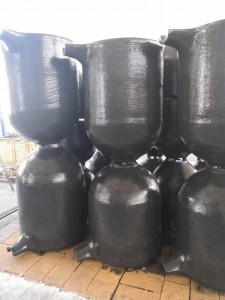
Crucibles are important tools in various industries for handling melting and smelting processes. It is a container that can withstand high temperatures and is used to hold substances and heat them to their melting point. Different types of crucibles are used depending on the specific requirements of the material being melted or smelted. In this blog post, we will explore the different types of crucibles and their applications.
1. Iron crucible:
Use an iron crucible when melting strong alkaline substances such as NaOH. However, it has not been widely used due to problems such as easy rusting and oxidation. In most applications involving alkaline materials, inert metal crucibles remain the preferred choice.
2. Cast iron crucible:
Cast iron crucibles are made from pig iron and are known for their durability. It is used to melt various metal alloys including aluminum, zinc, lead, tin and antimony alloys. Compared to iron crucibles, cast iron crucibles are more durable and can withstand the high temperatures required to melt these alloys.
3. Quartz crucible:
Quartz crucibles are commonly used in the semiconductor industry and are essential for the production of large-scale integrated circuits. These crucibles can withstand temperatures up to 1650 degrees and are available in clear and opaque versions. Translucent quartz crucible manufactured by arc method, used for pulling large diameter single crystal silicon. It has the advantages of high purity, strong temperature resistance, large size, high precision, good thermal insulation performance, energy saving, and stable quality. However, care should be taken as quartz is brittle and can break easily.
4. Porcelain crucible:
Ceramic crucibles are popular for their chemical resistance and affordability. However, it cannot be used to melt alkaline substances such as NaOH, Na2O2, Na2CO3, etc., because they will react with porcelain and cause corrosion. In addition, porcelain crucibles should not come into contact with hydrofluoric acid. They are suitable for use at temperatures around 1200 degrees.
5. Corundum crucible:
Corundum crucible is very suitable for melting samples using weakly alkaline substances such as anhydrous Na 2 CO 3 as a flux. However, they are not suitable for melting samples using strongly alkaline substances (such as Na2O2, NaOH) or acidic substances (such as K2S2O7) as fluxes.
6. Graphite crucible:
Graphite crucibles are widely used in the metal casting industry due to their excellent thermal conductivity and high temperature resistance. They are suitable for melting a variety of metals including copper, gold, silver and brass.
7. Silicon carbide crucible:
Silicon carbide crucibles are known for their high thermal conductivity and excellent chemical resistance. They are used in melting and smelting processes involving high temperature applications, such as the production of ceramics and alloys.
Each type of crucible has its own unique advantages and applications. Crucible selection depends on factors such as the material being melted or smelted, the desired temperature range and budget. Whether you are melting copper, casting metal, or smelting alloys, choosing the right crucible is critical to a successful and efficient operation.
In summary, crucibles play a vital role in various industries involving melting and smelting processes. Understanding the different types of crucibles available and their specific applications can help businesses make informed decisions about which crucible to use to meet their specific needs. Whether it is iron crucible, cast iron crucible, quartz crucible, porcelain crucible, corundum crucible, graphite crucible or silicon carbide crucible, each type has its own advantages and limitations. By choosing the right crucible, businesses can optimize their operations and ensure high-quality results.
Post time: Nov-15-2023
